Home to many natural hot springs, the now-TV-famous Ozarks, and the first woman elected to the U.S. Senate (Hattie Caraway in 1932), Arkansas is a beautiful state in the southern United States. Its beauty, then, can only be increased by its population of native plants, some of which are under threat by dangerous invasive plant species.
In this article, we will discuss the meaning and importance of native plants, provide you with a list of just some of those species that call Arkansas home, and introduce you to some of their worst invasive enemies. Then, we’ll offer some great ways that you as a home gardener can help protect your state’s native plants in the hopes that you will make your landscape a bit more resilient to the effects of climate change.
The Importance of Native Plants
In a time when plants are all the rage, many home gardeners will have heard a bit about native plants. You may know that they are important and that more and more gardeners are deciding to use them in their landscapes rather than introduced species. If you know this, you’d be correct!
But why are native plants so important and what exactly are they? Well, native plants are plant species that occur naturally in a given area. They may be trees, shrubs, herbaceous perennials, and even weeds, but they all call a certain part of the world their natural home. On the other hand, introduced plant species are those that have been brought here, sometimes by animals, abiotic natural events like the wind, or even by gardeners like you and me. Some of these species are harmless, living in harmony with native plants and animals. Others, however, become invasive, out-competing and sometimes killing native plants and their dependents.
That is why native plants are so important. They belong in a given place, so they help nourish their natural landscapes, feeding animals and giving them shelter, rejuvenating the soils, and creating more biodiversity, which in turn helps sustain ecosystems.
Natives Plants of Arkansas
As with every state, there are many native plants that call Arkansas home! From tiny herbaceous perennials to enormous trees, there are countless plants to choose from if you’re looking to create or improve your native garden. Below, we’ve listed just a few natives in their various categories in hopes that your landscape will feature these beautiful plants, rather than those that belong in other parts of the world.
Perennials
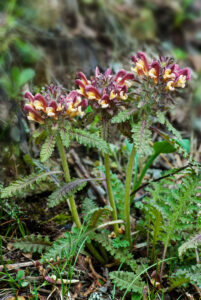
Wood-Betony (Pedicularis canadensis)
With hairy, fern-like foliage, wood betony may be a familiar native plant to those from eastern North America. They typically reside in woodlands and prairies, displaying a tint of red in their green leaves and hooked pinkish-yellow flowers that are great for bees and creatures with long proboscises. However, as dainty as it seems, wood betony is also known to be semi-parasitic (also called a hemiparasite), stealing water and nutrients from its host plants, like oak trees, if it doesn’t need to use its own roots.
Swamp Milkweed (Asclepias incarnata)
One of the most common native perennials in the United States, swamp milkweed can be found in swamps and wetlands, as its name suggests. With flowers that serve as a great food source for butterflies and other pollinators, milkweed is well known for its thick, latex-like secretion – or “milk” – that seeps from its leaves and stems when injured. This secretion can cause irritation, so make sure not to let your skin touch it if you accidentally break off a piece of this plant.
Woodland Pinkroot (Spigelia marilandica)
Also known as Indian pinkroot, this native plant is typically found in woodlands, as it enjoys shady areas. It is a great option for a shady spot of any native Arkansas garden! Mostly used as an ornamental herb, woodland pinkroot is a great source of food for hummingbirds. Its small, long, red and yellow flowers are perfect for hummingbirds’ long tongues! However, this native has also been used as a remedy for removing tapeworms from the body; one would dry the roots, ingest them, and expel both pinkroot roots and tapeworm to avoid any toxicity from the plant itself.
Shrubs
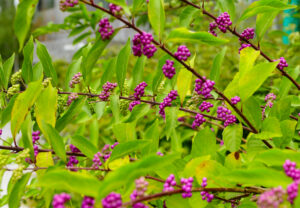
American Beautyberry (Callicarpa americana)
A stunning shrub that will bring interest and color to your garden, American beautyberry is a truly beautiful native plant! Typically reaching three to five feet in height, this native is a great choice for its design aesthetic as well as its ecological benefits. American beautyberry’s bright magenta berries will bring brightness as well as birds to your space, serving as a great food source for them as they flutter through the landscape. Though the berries are edible for humans as well, they mustn’t be eaten in large amounts, as they are quite acidic. However, the roots of the American beautyberry have been used traditionally in teas and its leaves are known to be effective at repelling pesky insects.
Stern’s Medlar (Crataemespilus canescens)
An extremely rare shrub, Stern’s Medlar is native only to a portion of Arkansas, meaning it is not only native, but endemic to the state. Discovered not too long ago in 1969 by environmentalist Jane Ellenbogen Stern, this native shrub was determined to be a naturally occurring hybrid of two types of rose family plants, a medlar and a hawthorn! With attractive, small white flowers, interesting reddish-orange round fruit, and yellow foliage in Autumn, Stern’s medlar is a curious case of botany in the U.S. It is extremely difficult to propagate, both from seed and cutting, which is probably why it’s so rare in nature.
Ozark Mock Orange (Philadelphus pubescens)
Named for its flower’s resemblance to that of a true orange, the Ozark mock orange is actually a shrub in the hydrangea family. Growing from four to ten feet in height, this Arkansas native can mainly be found in the Ozarks (as its name also suggests) as well as any wooded, possibly sloped areas near streams in the southeastern and central U.S. Its blossoms are soft and fragrant, bringing delight to any who pass it. Don’t eat its fruit though, because, unlike the true orange, the Ozark mock orange is not edible; in fact, it may even be toxic to cats, so keep that in mind if you’re creating a cat friendly native garden.
Trees
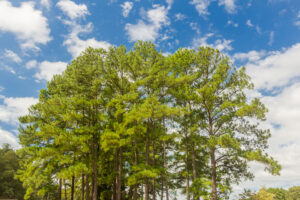
Loblolly Pine (Pinus taeda)
Arkansas’s state tree, the loblolly pine is certainly the most common pine tree in the landscape. Its residence has been extremely important to Arkansas’s economy of the past and present, allowing their timber industry to flourish. The loblolly pine is a fast grower, losing its lower branches early on and forming a rounded shape at the top. Its needles are soft, creating an airy image from far away. Plus, its bright red bark adds a pop of color to any landscape, as long as the soil’s moisture is dry to average and light level is full sun to partial shade.
Yaupon Holly (Ilex vomitoria)
A small native tree with a very interesting backstory, yaupon holly is a great deciduous plant for any Arkansas garden that gets full sun. As you may have noticed, its latin species name “vomitoria” is quite shocking. The reason for this name is due to the plant’s high caffeine content; those who ingested it after roasting would occasionally vomit from its strength! Today, though, you can simply use a yaupon holly as a small accent tree. As it ages, its branches begin to droop down, creating a lovely weeping effect that’s great for interest in the garden.
Pawpaw (Asimina triloba)
Part of the custard apple family, the native pawpaw is a small fruiting tree perfect for the understory of a larger space or a specimen tree for a smaller garden. Found all throughout the state of Arkansas, pawpaws are also known as the Arkansas Banana, and are famous for their delicious, custard-like fruit! Their name originates from early English settlers’ original name for the papaya, which they seemed to have mistaken this tree for, though they aren’t even in the same family! In spring, pawpaws display small, bell-shaped flowers of a deep red hue that give way to large fruits in late summer and fall. However, if you are thinking of adding this native to your garden, you may want to plant a couple. Pawpaws are trioecious, meaning they can either have male and female parts on one plant or on two, making it difficult to grow their fruit if you happen to plant a pawpaw with just one type of flower.
Grasses
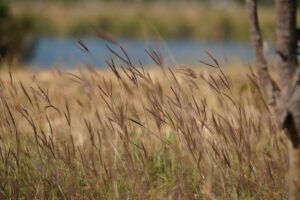
As part of efforts to replenish American grasslands and sequester more carbon, the government of Arkansas – and those of many grassland states – is attempting to replace invasive grasses with native ones. The most troublesome and widespread invasive, Tall Fescue, will be discussed later in this article. However, you can do your part to help reintroduce native grasses to Arkansas by growing one of the following native grasses in your own landscape!
Big Bluestem (Andropogon gerardii)
A widespread native prairie grass, big bluestem is a great choice for wide open, fertile spaces! Also called Turkeyfoot, its inflorescence appears in fall, resembling the foot of a turkey and spreading its seeds for the next year. Big bluestem is great for livestock feed, as well as shelter for birds and small mammals, as it can grow up to 12 feet!
Little Bluestem (Schizachyrium scoparium)
A native neighbor of big bluestem, little bluestem is a bit smaller in height than its cousin. Both have blueish green leaves, but little bluestem’s inflorescence is quite different! Its flowers form white, fluffy seeds able to float around the landscape and multiply!
Indiangrass (Sorghastrum nutans)
Growing up to six feet tall, Indiangrass is a great choice for summer and fall interest in the garden. Bearing seeds that can survive a range of weather conditions, Indiangrass can be found in areas that aren’t necessarily prairies, making it very versatile. Its inflorescence makes a grand display in late summer, washing the landscape in gold! Once the seeds mature, the flower heads change shape to look like an inverted cone, spreading copper seeds as far as the wind can take them!
Arkansas’s Invasive Plants

As opposed to native plants, invasives are actually quite harmful to the environment. Where natives help bring about ecological biodiversity, replenish soil richness, and aid in restoring landscapes to their natural beauty, invasives harm ecosystems, drain the soil of minerals, and make landscapes across the world far less diverse.
Below, we have listed five of Arkansas’s worst invasive plants in hopes that you find a way to remove them from your own garden! Each of these plants belong elsewhere, in parts of the world where they are helpful to ecosystems, not harmful. In Arkansas, these plants compete with and defeat native species by many means. Some invasive plants produce hundreds or even thousands of tough seeds per plant, others send out deep roots and wide shoots to absorb much of the soil’s nutrients, and still others release chemicals to kill off other plants! Their removal is of the utmost importance to the health and longevity of Arkansas’s climate and natural habitats.
Tall Fescue (Festuca arundinacea)
Native to Europe and introduced in the colonial era as a quick growing, quick spreading feed for livestock, tall fescue is one of the most detrimental menaces to the American grasslands. Since it grows quickly via rhizomes, its root system isn’t all that deep, allowing the top layers of soil to remain dry. Tall fescue is great at out-competing native grasses, as it forms dense clumps that make it difficult for natives to find a suitable spot. Plus, this invasive releases chemicals that make it more difficult for native seeds to grow.
Mimosa (Albizia julibrissin)
A truly magical looking tree, mimosa has feathery leaves and fragrant pink flowers that resemble floating seeds from Avatar! It’s easy to grow and a source of great beauty and sweet scents in the summer. However, this Asian native is also a great threat to American native plants. Its many fluffy seeds easily float long distances, allowing new mimosas to pop up all over, and in most types of soil. Even chopping a mimosa tree down to its base may not kill this invasive; it easily sends up new suckers, ready to take over the landscape.
Chinese Privet (Ligustrum sinense)
Often found as an ornamental shrub, Chinese Privet is a very aggressive, thicket-forming shrub. Though it does have attractive fragrant flowers and can fill a space quickly, its invasive nature in the U.S. makes Chinese Privet a poor choice for your home garden. It will surely take over the space, eliminating the chance for other native plants to take root as it spreads quickly via runners and seed-spreading animals.
Spotted Knapweed (Centaurea stoebe)
A biennial or perennial (depending on the climate), this purple-flowered noxious weed is a nightmare for native plants. Growing well in dry conditions, you may find spotted knapweed in clearings of forests, along highways, in empty lots, along the sides of mountains and rocks, and even in your own backyard. Each plant produces about 1,000 seeds, each surviving without germination for up to eight years!
Crown Vetch (Securigera varia)
A low-growing weed with crown-shaped blooms, crown vetch used to be a favorite amongst gardeners and conservationists. Its use of rhizomes helps it spread far and wide, creating thick blankets on the ground and over other plants. This ability used to be favorable, as crown vetch was used to fight off the erosion of soils. However, today, this false vetch is recognized by many to be invasive, as it out-competes many native neighbors.
5 Things You Can Do to Help Arkansas’s Native Plants
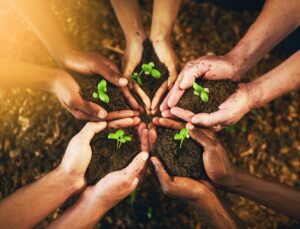
Arkansas’s native plants and trees face threats from climate change, habitat loss, and invasive species. Conservation efforts are underway to protect them. Initiatives include reforestation projects, the establishment of protected areas, and the promotion of sustainable harvesting practices.
But, as a home gardener, you may wonder how you can get involved, how you can help protect Arkansas’s native plant population. Well, don’t you worry, because we’ve compiled a list of 5 things you can do to help!
1. Bye bye, Invasive Plants!
As long as you have the right equipment – gloves, soil knives, and pruners – feel free to help the environment by getting rid of invasive plants like the ones listed above!
2. Hello, Native Plants!
Once you remove those pesky invasive plants from your landscape, why not replace them with helpful natives? Visit your local garden center for fully grown specimens or simply start off with seeds, like Swamp Milkweed, American Beautyberry, or Big Bluestem Grass!
3. Welcome Home, Pollinators!
One surefire way to help native plants is to help their pollinators! Refrain from using harmful pesticides in the garden, as they will kill pests as well as pollinators. Plus, you could even purchase things like bee boxes or birdhouses to make pollinators and seed spreaders feel welcome in your space!
4. Natural Fertilizers!
Sometimes, you may want to give your native plants some extra love with fertilizers. However, there’s really no need to drench the earth with harsh chemicals to do so. Instead, try using natural fertilizers like liquid seaweed!
5. Get Involved!
Chances are, if you’re interested in helping out the environment in your neighborhood, others are, as well. So, check out your local parks departments, botanic gardens, and arboretums to see if they’re hosting any volunteer activities. You may find outings to remove invasives from parks, install natives in gardens, or care for city trees! But, of course, sometimes the most important place to start is your own backyard!
